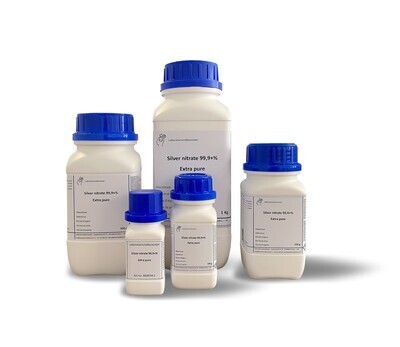Verzending 24–48 u • Levering in de hele EU • Veilige chemieverpakking
Potassium peroxodisulfate 99+% 1 g
SKU 006521
€ 81,00
In stock
1
Save this product for later
Potassium peroxodisulfate 99+% 1 g
Product Details
CAS number: 7727-21-1
Chemical formulas: K2S2O8/ F.W. 270.33
Cation: K
Packaging: 1 g
EAN: 8721028244215
Brand: Laboratoriumdiscounter
Potassium peroxodisulfate is a powerful oxidizing agent used in various industrial and laboratory applications. It is commonly used in hair bleaching, polymerization reactions, and water treatment processes. This compound is highly reactive and can cause severe skin and eye irritation, making it important to handle with care.
When working with Potassium peroxodisulfate, it is important to follow safety instructions to ensure your well-being and prevent any accidents. Here are some short safety instructions to keep in mind: 1. Personal Protective Equipment (PPE): Always wear appropriate PPE, including safety goggles, gloves, and a lab coat or protective clothing. This will protect your eyes, skin, and clothing from potential contact with the chemical. 2. Ventilation: Work in a well-ventilated area or use a fume hood to prevent the accumulation of any potentially harmful fumes or gases. 3. Storage: Store Potassium peroxodisulfate in a cool, dry, and well-ventilated area away from incompatible substances. Keep it tightly sealed in its original container and away from sources of heat or ignition. 4. Handling: When handling Potassium peroxodisulfate, avoid direct contact with the skin or eyes. In case of accidental contact, immediately rinse the affected area with plenty of water for at least 15 minutes and seek medical attention if necessary. 5. Mixing and Dilution: Always add Potassium peroxodisulfate to water slowly and carefully, never the other way around. This will help prevent the generation of excessive heat or splattering. 6. Fire Safety: Potassium peroxodisulfate is a strong oxidizing agent and can support combustion. Keep it away from flammable materials and sources of ignition. In case of a fire, use appropriate extinguishing agents such as dry chemical powder or carbon dioxide. 7. Spills and Leaks: In case of a spill or leak, contain the area and prevent the spread of the chemical. Use appropriate absorbent materials to clean up the spill and dispose of them according to local regulations. 8. Disposal: Dispose of Potassium peroxodisulfate according to local regulations and guidelines. Do not pour it down the drain or dispose of it with regular waste. Remember, these are just general safety instructions, and it is essential to consult the specific safety data sheet (SDS) and follow the instructions provided by the manufacturer for the particular Potassium peroxodisulfate product you are using.
Please note, not all safety data for this product is available on our website, for a complete list of P en H sentences and other safety instructions please request the MSDS at our customer service
You May Also Like

3-Methoxy-3-oxopropanoic acid, 95.00%, 5g
3-Methoxy-3-oxopropanoic acid, 95.00%, 5g
SKU F227679-5G
€ 22,00

Accessories interchangeable block for reaction vessels, combination interchangeable blocks, Gesch. for, 18/10 reaction vessels 1.5/2.0 ml, 1 piece
Accessories interchangeable block for reaction vessels, combination interchangeable blocks, Gesch. for, 18/10 reaction vessels 1.5/2.0 ml, 1 piece
SKU CTP4.1
€ 126,31
Display prices in:EUR




![3-AMINO-4-FURAN-2-YL-5,6,7,8,9,10,11,11A-OCTAHYDRO-4AH-1-THIA-12-AZA-CYCLONONA[F]INDENE-2-CARBOXYLIC ACID AMIDE, 98.0%, 25mg 3-AMINO-4-FURAN-2-YL-5,6,7,8,9,10,11,11A-OCTAHYDRO-4AH-1-THIA-12-AZA-CYCLONONA[F]INDENE-2-CARBOXYLIC ACID AMIDE, 98.0%, 25mg](https://d2j6dbq0eux0bg.cloudfront.net/images/88473019/4861329906.png)

![N-Boc-2-{2-[2-(2-amino-ethoxy)-ethoxy]-ethoxy} ethylamine, 98.0%, 5g N-Boc-2-{2-[2-(2-amino-ethoxy)-ethoxy]-ethoxy} ethylamine, 98.0%, 5g](https://d2j6dbq0eux0bg.cloudfront.net/images/88473019/4772129379.png)


![[6]-Shogaol>90.0%(HPLC)25mg [6]-Shogaol>90.0%(HPLC)25mg](https://d2j6dbq0eux0bg.cloudfront.net/images/88473019/4042562789.jpg)

